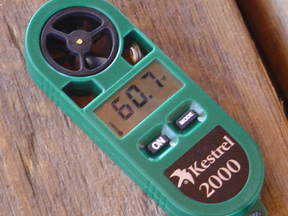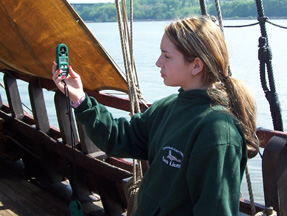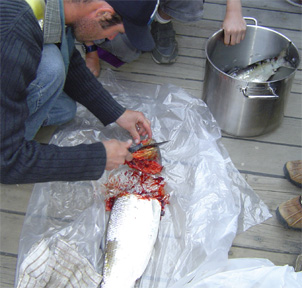 |
|
River SciencePage One Page Two |
|
 |
Quick Links: Current Speed |
Wind Speed
For centuries, wind speed and direction would make all the difference between a swift voyage or spending weeks adrift for sailing vessels like the Half Moon. As you can see Kiera doing above, our students used hand-held anemometers to measure the wind speed, recording peak and average wind speeds throughout the day. Checking wind direction is quite a bit easier. If holding a wet thumb in the air won't do, just look up at the flags! |
|
Air TemperatureAir temperature is also an important concern. Extreme temperatures -- whether it's blistering hot out or chillingly cold -- can have deleterious effects on the most important part of the ship: its crew! Above, you can see some of the instruments our students use to measure air temperature, barometric pressure, and water temperature. |
|
Cloud Formations
An experienced mariner can often forecast the weather just by examining the clouds. Clouds come in many forms and varieties, and a cloud's shape offers distinct, visual clues as to the movements of cold fronts and other otherwise invisible weather phenemomena. For example, the bold line of dark clouds in the upper left photo signal the rapid approach of an oncoming, violent thunderstorm. On the other hand, the puffy white clouds behind Captain Washington to the right indicate a pleasant afternoon. |
|
Mechanical AdvantageMechanical advantage is the ratio of output force divided by input force in a simple machine, such as a pulley, lever, or winch. The greater a machine's mechanical advantage, the greater its output force compared to its input force. In other words, simple machines with positive mechanical advantage make it easier to lift or move heavy objects. Since our students focused on river and weather science for their group presentations, no one specifically studied mechanical advantage on this particular Voyage of Discovery. However, by its very nature the Half Moon immerses our crew in the importance of this scientific principle. The Half Moon simply could not exist without all the many simple machines it uses for a wide variety of purposes. The capstan you can see above is a winch used to lift massive weights, such as the topmasts or the anchor. The anchor alone weighs over 400 lbs., so the total load on the capstan (including the anchor, chain, line, and the strain of pulling the ship against the current) while weighing anchor can approach a ton. Despite this, with the capstan's help, just eight students working on the weather deck can raise our anchor without a hitch. (If we really needed to, we could add eight more crew to the capstan down on the orlop deck.)
Another example of a vital simple machine is the whipstaff we use to steer the ship. The whipstaff is a simple lever that allows a single crewmember to easily push the ship's massive rudder and tiller back and forth. Last but not least, we also use dozens of blocks (pulleys) in the rigging to handle the sails.
|
|
WildlifeWhile our crews are onboard the Half Moon, they are continually surrounded by the natural world. Every day brings new opportunities to study (or just admire) the local flora and fauna. On this Voyage of Discovery, we were frequently accompanied by various kinds of avian wildlife, from the swan (left) who visited us one morning, to the blue herons often seen buzzing the river's surface, immature eagles, Canadian geese headed north, and a dramatic duel between crows and a red-tail hawk. Even the discovery of "Zack the Quack," a discarded decoy duck found along Athens Channel, led to new routes of study.
The avid fishermen we had onboard also presented us with opportunities to examine the local marine wildlife. A pair of neighborly fishmen presented our crew with the unfortunate fellow (which Dylan is proudly presenting) to the right as a gift. This shad was later dissected, then used for bait. You can see some of the dissection below. (If you'd like to see more, move your mouse over the picture.) |
|


